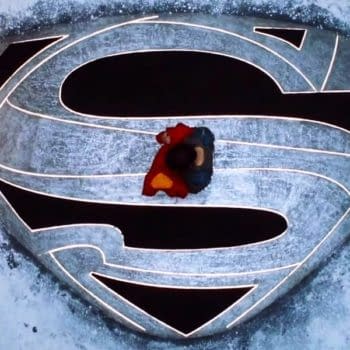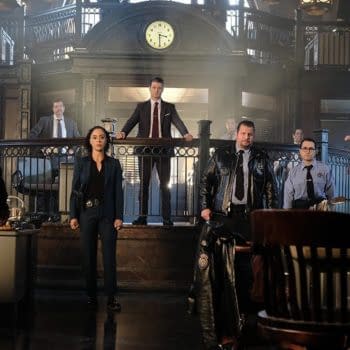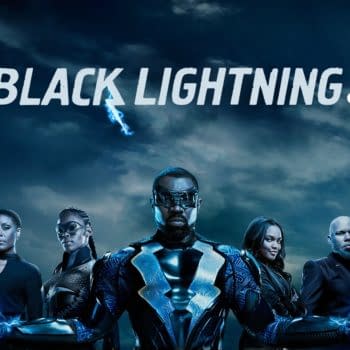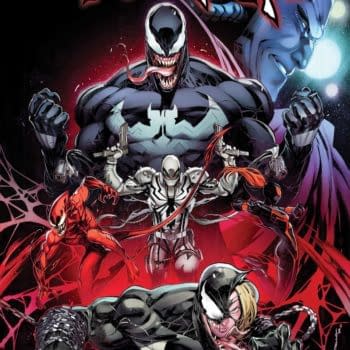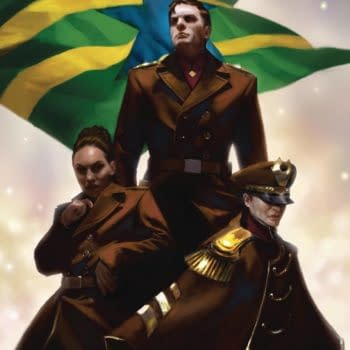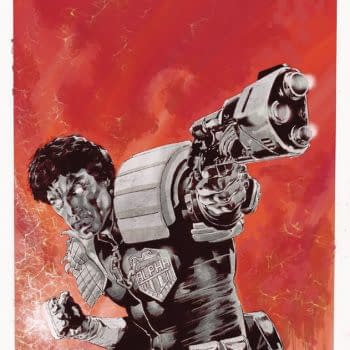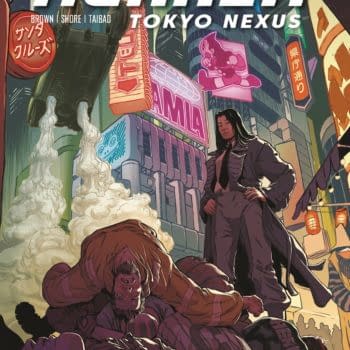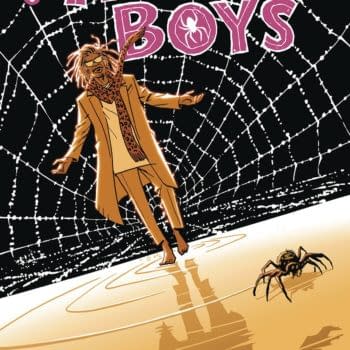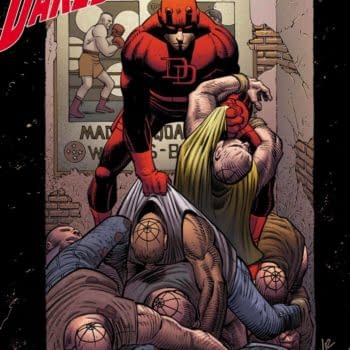Posted in: Comics | Tagged: Comics, dynamite, Ediano Silva, entertainment, F. Wesley Schneider, HRL, Pathfinder Runescars
Writer's Commentary: F. Wesley Schneider Talks Pathfinder: Runescars #3
Straight from Dynamite, here's a new writer's commentary from F. Wesley Schneider for Pathfinder: Runescars #3 with cover by Jonathan Lau and interiors by Ediano Silva.
Issue #3 of the new Pathfinder series opens with our heroes under lock and key — captives of the merciless, devil-allied Hellknights. Go read the book then come back and enjoy the footnotes!
Page 1:
The scene opens soon after the close of Runescars #2, where our heroes' foray into Citadel Vraid — home of the notorious Order of the Nail Hellknights — did not end so well. Valeros attempts to keep the party's spirits up, but Kyra knows the Hellknight have little patience for smart-mouthing. Valeros exhibits for the thousandth time that he should follow his companions' advice.
Page 2 & 3:
Valeros skids into this introduction to the Order of the Nail's high command. Severs DiViri, Lictor of the Order of Nail, stands front and center before a host of Hellknight leaders and their infernal allies. DiViri is the law-obsessed leader of Varisia's Hellknights, a military commander devoted to an unflinching vision of law. Spreading the Hellknights' vicious brand of justice across Varisia is no small job, though. DiViri's been at this for years, he's skilled, but he's also tired, and has little time for the heroes' interruptions.
Pay close attention and you'll see that Ediano also worked maps of Varisia in among DiViri's plans and trophies.
Page 4:
DiViri might be curt, but Seoni knows something the rigid commander won't be able to tolerate. Maybe by giving away Lazku's violation of the Hellknights' strictures she'll be able to divert DiViri's ire.
It's a scheme that seems like it should work, but DiViri's seen it all. He's a fanatic — but a veteran fanatic. He's got a "punish them all and don't bother sorting them out later" mentality. I like the idea of a villain who's devoted to his cause, but he's getting old and is bored with the day-to-day atrocities. He doesn't have time to waste, which I wanted to come across in his "let's get this over and done with" attitude.
Page 5:
The Order of the Nail's mystical commander, Paravicar Acillmar, provides us with a quick check-in on Signifer Lazku, the heroes' real objective. She's still at work trying to find her way into ancient Thassilonian ruins. We'll get a bit more on her in the next issue, though.
Page 6 & 7:
To DiViri's frustration, his orders are overruled by the only law he has to concede to: Hell's own law. And, unfortunately for DiViri, a consulting contract devil is on hand to explain the baroque legality of Tanin's request. This is one of the fun parts of Hellknights as villains, they're bound to a goal and calling that sometimes works against them in fun ways.
But, there are always loopholes.
Page 8 & 9:
The heroes don't get the sort of swift justice they might have been hoping for. They're hardly getting the worst of it, though. Here we're introduced to two Shoani — tribal members of one of Varisia's two native cultures (the other being Seoni's people, the Varisians).
As for the Hives, they're part of Citadel Vraid's relatively unique/brutal prisons. These pit cells were first described in the RPG accessory Pathfinder Campaign Setting: Castles of the Inner Sea. They're oubliettes, perfect for forgetting about unwanted prisoners. While the heroes won't spend long here, they were too perfect an in-world detail not to throw in.
Page 10 & 11:
Our new friends Astra and Arouchs explain some of the imperialistic horrors the Shoanti and Varisians have been suffering at the hands of the Hellknights (and Chelaxian colonists) for centuries. It's a situation that's rigged against the Shoanti, and is a greater issue than the heroes are likely to be able to solve with swords and spells. Tanin's focus is on an immediate issue, though — their individual freedom. We don't explore that Tanin's also part of the same Southland military tradition working to drive the Shoanti off their lands, but that's a topic for another (far longer) series.
Page 12 & 13:
I love the noose Ediano worked in here — a nice little "screw you" from the Hellknights dragging the prisoners up.
The heroes might not have come to help the Shoanti with their situation, but their fates get entangled all the same. The Shoanti are born warriors, so they're all too ready to fight.
Page 14:
Half of Citadel Vraid turned out for Tanin's duel. In the background we can see rank-and-file Hellknights and signifers — Lazku's brethren. I love how Paravicar Acillmar's armor came out here. As Vraid's highest-ranking spellcaster, I dig how his getup is part armor, part wizards' robes (favoring the former).
This matter of signifers as armored mages has come up again and again in the Pathfinder game: why would Hellknight spellcasters wear armor when, in the game, that's a significantly suboptimal choice?
It largely comes down to a matter of pride and earned respect. Signifers need to prove that they're every bit as much "Hellknight" as their martial brethren. They can't take the easy route of doffing their armor in favor of airy robes and trading in halberds and lances for darts and daggers. They wouldn't be respected by their martial fellows if they were seen as physically less capable. While there's likely opinions and frictions between the martial and spellcasting Hellknights, none can say that the signifers aren't every bit as willing to endure the same discomforts and physical hardships as Hellknight infantry. And if that comes at the cost of spellcasting efficacy, it's better to have that happen with a legion of siblings-in-arms at one's back than fellows eager to see you fail.
Page 15 & 16:
We've seen a lot of devils since the heroes came to Citadel DiViri, but I wasn't about to let them escape without conjuring in one of my favorites: a crab-legged brute I designed for the first of Pathfinder's Book of the Damned accessories, a warmonger devil (or, my preferred name, a levaloch). These aren't you classic red-horned, spiky-tailed devils. They're shock troops, epitomes of Hell as a land of endless war. They're not schemers or tricksters, they're not interested in deals or contracts, they exist to slaughter all who would oppose Hell's march across worlds and planes. They're perhaps the most "Hellknight" of Hell's forces — dark, armored, and efficient — so drawing in a levaloch as Tanin's opponent seemed like a perfect fit!
Pages 17 & 18:
The battle doesn't go fantastically. We get brief snippets of how most of the heroes fight — charging in, ranged harassment, spellcasting, coordinated attacks — but nothing seems to work against a creature made of evil and war given form.
Page 19:
The ultimate result of this comes with a single crimson slash from the levaloch.
Page 20 & 21:
After a drawn out fight, though, we see the heroes have "leveled up" a bit over the course of their adventures. After getting softened up by the others, the levaloch falls to Seoni's scorching ray. The heroes have moved a good ways beyond cracking goblin heads… but that doesn't mean they're ready to face every threat.
DiViri's halberd glows with some fantastically powerful magical effect as is depicted in Pathfinder Campaign Setting: Path of the Hellknight (perhaps brilliant energy — Pathfinder's answer to particularly murdery lightsabers?).
For the effect, just turn the page.
Thanks for checking out Pathfinder: Runescars, everyone! Be sure to keep reading for more Pathfinder adventure from Paizo developer Jason Keeley–more infernal action ready to hit your game table whenever you need to bring Hell's servants to bear.
And next month, Sutter explores a dungeon inhabited by far worse than dragons!









